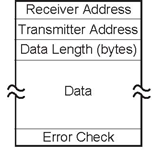Focusing on electrical networks, most analog ones make inefficient use of communication links because truly dynamic routing is difficult, if not impossible, to obtain. In radio networks, such as commercial television, each station has a dedicated portion of the electromagnetic spectrum, and this spectrum cannot be shared with other stations or used in any other than the regulated way. The telephone network is more dynamic, but once it establishes a call the path through the network is fixed. The users of that path control its use, and may not make efficient use of it (long pauses while one person thinks, for example). Telephone network customers would be quite upset if the telephone company momentarily disconnected the path so that someone else could use it. This kind of connection through a network fixed for the duration of the communication session is known as a circuit-switched connection.
During the 1960s, it was becoming clear that not only was digital communication technically superior, but also that the wide variety of communication modes computer login, file transfer, and electronic mail needed a different approach than point-to-point. The notion of computer networks was born then, and what was then called the ARPANET, now called the Internet, was born. Computer networks elaborate the basic network model by subdividing messages into smaller chunks called packets (Figure 6.26). The rationale for the network enforcing smaller transmissions was that large file transfers would consume network resources all along the route, and, because of the long transmission time, a communication failure might require retransmission of the entire file. By creating packets, each of which has its own address and is routed independently of others, the network can better manage congestion. The analogy is that the postal service, rather than sending a long letter in the envelope you provide, opens the envelope, places each page in a separate envelope, and using the address on your envelope, addresses each page's envelope accordingly, and mails them separately. The network does need to make sure packet sequence (page numbering) is maintained, and the network exit point must reassemble the original message accordingly.

Long messages, such as files, are broken into separate packets, then transmitted over computer networks. A packet, like a letter, contains the destination address, the return address (trans mitter address), and the data. The data includes the message part and a sequence number identifying its order in the transmitted message.
Communications networks are now categorized according to whether they use packets or not. A system like the telephone network is said to be circuit switched: The network establishes a fixed route that lasts the entire duration of the message. Circuit switching has the advantage that once the route is determined, the users can use the capacity provided them however they like. Its main disadvantage is that the users may not use their capacity efficiently, clogging network links and nodes along the way. Packet-switched networks continuously monitor network utilization and route messages accordingly. Thus, messages can, on the average, be delivered efficiently, but the network cannot guarantee a specific amount of capacity to the users.
- 瀏覽次數:2215






